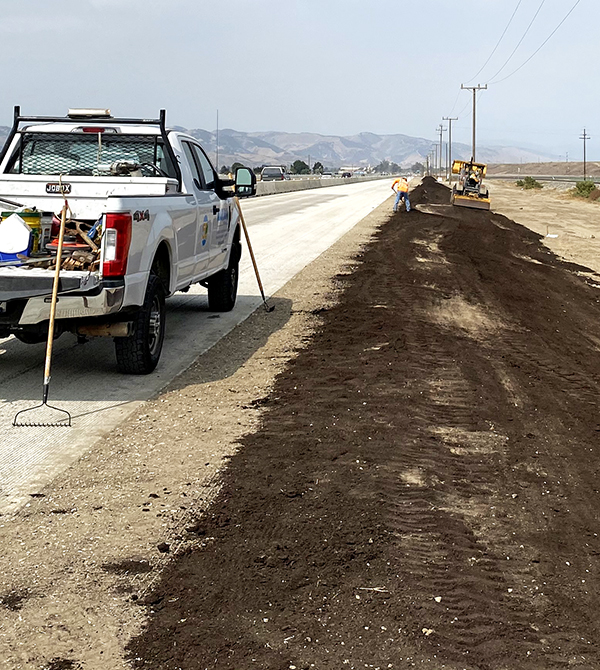Top: Mixed waste compost at Z-Best after the first phase of composting (foreground) and the screened material going through additional composting in background.
Nora Goldstein
Zanker Recycling and GreenWaste, sister companies based in San Jose, California, have been collecting, preprocessing and composting mixed solid waste and source separated yard trimmings for over 20 years. Their portfolio of processing facilities includes GreenWaste Materials Recovery Facility (MRF) and the Zero Waste Energy Development Company (ZWED) anaerobic digester in San Jose, and Z-Best Composting in Gilroy.
GreenWaste specializes in the collection and processing of waste generated by residents and businesses, which can include trash, yard trimmings, recyclable materials and food waste. It was originally formed in 1991 to provide yard trimmings collection and processing services to the City of San Jose. The Z-Best Composting Facility was constructed in 1997 to produce compost from yard trimmings. In 2001, a separate composting line was installed to process the organic fraction of municipal solid waste (MSW) separated out at the GreenWaste MRF. The ZWED dry fermentation digester began receiving “organics-rich” MSW from the commercial sector in late 2013.
Zanker and GreenWaste’s infrastructure to collect and process organic waste is expected to grow as jurisdictions seek to comply with SB 1383, California’s Short-Lived Climate Pollutants Reduction Act signed into law in 2016. SB 1383 requires a 50% reduction in organic waste disposal from 2014 levels by 2020, and a 75% reduction by 2025. Regulations to implement SB 1383 were finalized in November 2020; the law (and compliance with it) goes into effect on January 1, 2022.
“In northern California, yard waste is being collected by the majority of jurisdictions,” notes Michael Gross, Zanker Recycling’s Sustainability Director. “According to our analyses, programs that include food waste in their yard waste collection carts are getting 3% to 4% food scraps at best. Organics comprise 50% to 60% of the garbage, which won’t get jurisdictions to the 75% reduction in organic waste disposal by 2025. That is where the solid waste processing comes in. We plan to go after the organics in the MSW stream, and make a marketable product.”
Gross adds that jurisdictions with collection programs that include food scraps in the yard trimmings carts will likely continue that approach to organics diversion. “The question is how to get the rest of the organics out of commercial and residential waste,” he says. “So Zanker/GreenWaste will go after both clean and dirty organics. Our approach is to keep the yard waste separate and leave the food scraps in the trash cart.”
Z-Best Composting
The clean organics are the yard trimmings collected by GreenWaste and transported to the Z-Best Composting Facility in Gilroy. The facility is currently permitted to accept up to 1,500 tons/day of both yard trimmings and mixed solid waste feedstocks. The yard trimmings are composted to produce over 120,000 tons/year of OMRI-listed (Organic Materials Review Institute) Z-Best Organic Compost. The more challenging feedstock, MSW with its high trash content, is composted to produce about 55,000 tons/year of landscape compost.
“We receive an average of 680 tons/day of the mixed waste during the week,” says John Doyle, Z-Best’s Operations Manager. “Almost all of it has been processed at the GreenWaste MRF or anaerobically digested at our ZWED facility. We also receive some processed MSW from the Sunnyvale (CA) SMART Station.” Yard trimmings volumes vary with the season.
The MRF’s processing line includes screens, magnets, and other separation equipment to recover recyclables, mixed metals, cardboard, glass and plastic. The balance is processed MSW — containing food waste and other organics — that is transported to Z-Best for composting. A small amount of unprocessed MSW from collection routes closer to Z-Best is received at the facility and processed on-site prior to composting.
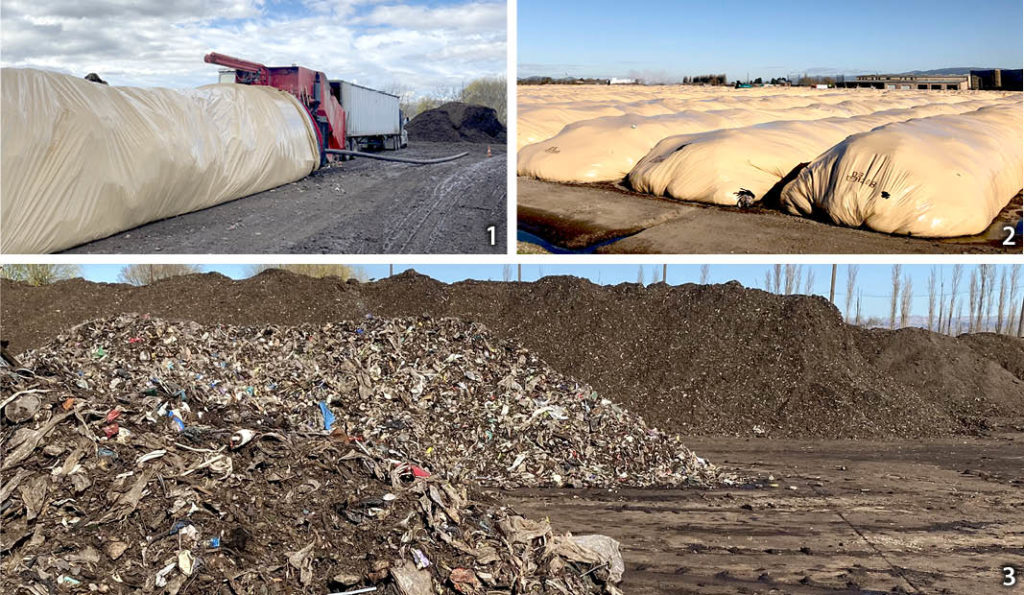
(1) Processed mixed waste and aeration pipe being loaded into CTI bag. (2) Material remains in CTI bags for 14 weeks, then (3) is harvested from the bags (foreground), screened and further composted in windrows (background). Photos courtesy of Zanker Recycling.
The processed MSW is loaded into high-density plastic bags (supplied by CTI) with aeration tubing. Material remains in the aerated bags for 14 weeks. “The required PFRP (process to further reduce pathogen) temperatures are achieved during that time,” notes Doyle. “After we harvest the composted material from the bags, it is screened to remove the bulk of the trash using a 1.25-inch ‘garbage’ trommel screen. A lot of film plastic and plastic bags are removed. We estimate the percent of trash in the harvested compost is right about 50% by weight. The fraction passing through the screen is further composted in windrows for 2 to 3 weeks and is turned regularly to facilitate moisture reduction and to further break down the material.”
The compost is then screened through a trommel with a 12 mm round screen (about 3/8th inch); the fines pass through a third trommel. The medium fraction, which is about 90% organic material, is processed through a hammermill, and then combined with the fines.
Markets, Facility Expansion
The yard trimmings are composted in a separate area at the Z-Best facility. After size reduction using a horizontal grinder, material is put in windrows and turned about twice a week. Water is added daily to help optimize composting conditions. After 14 to 18 weeks, the compost is screened.
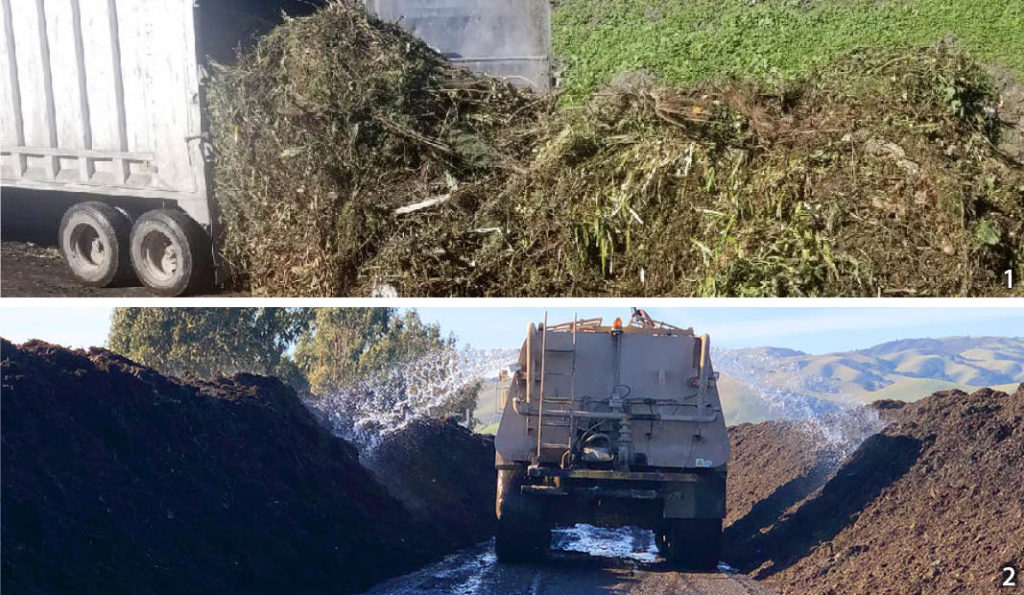
(1) Incoming yard trimmings are ground and put into windrows (2), which are turned twice a week and watered daily. Finished compost is certified organic and used primarily in agriculture.
About 125,000 to 130,000 tons/year of Z-Best Organic Compost are produced. The majority is sold to farmers. “We also have a significant blending operation for the organic growers,” says Doyle. “One of our main customers provides blends of our Organic Compost mixed with various additives to organic growers based on their soil analysis. This customer delivers the additives to Z-Best. We in turn receive orders with ‘recipes’ that involve blending of Organic Compost with specific additives. The ingredients are blended using a windrow turner. We charge a blending fee for this service, along with the sale of compost.”
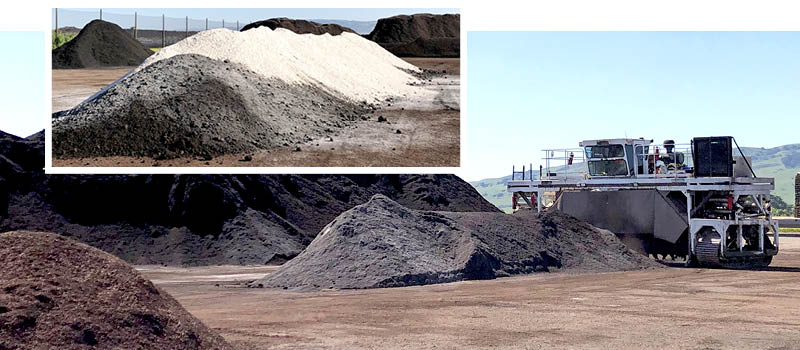
One of Z-Best’s main buyers of its Organic Compost is a company that supplies blends to organic farmers based on their soil analysis. The company supplies the additives (inset), which are blended with a windrow turner.
The processed MSW compost is sold to commercial landscapers, and some is purchased for CalTrans roadway projects. The compost is not certified organic. About 55,000 tons/year are manufactured.
Gross explains that the company cannot risk the potential contamination from commingling food waste with its yard trimmings collection. “We sell to row crop farmers growing lettuce and spinach, and they have zero tolerance for any contamination from glass and plastic,” he says. “We can’t afford it. These growers and packagers are shipping produce all over the world. We have this fantastic market, and we are not going to do anything to jeopardize it. So we tell jurisdictions to leave food waste in the trash cart, and we will make a different kind of compost with that material.”
In anticipation of SB 1383 compliance by jurisdictions, Z-Best is expanding its facility to accommodate higher volumes of processed MSW. An application to increase its permitted capacity to 2,750 tons/day has been submitted, and the company will be installing an Engineered Compost Systems’ (ECS) bunker-style aerated static pile composting system. “We are working with Santa Clara County on our CEQA (CA Environmental Quality Act) review, which is required to obtain the permit for our expansion,” explains Doyle. “Z-Best will stop using the CTI bags and instead compost in bunkers that have built in positive/negative aeration. We will utilize two 18-day cycles, putting the processed MSW in bays for an initial 18 days. Then, in order to agitate the material, those bays will be unloaded and the compost will be put in a different set of bays for 18 days.”
He adds that the ECS system will double Z-Best’s capacity to compost processed MSW. “We can compost twice as much material on the same footprint,” he says. “It will be much easier to handle materials versus loading the bags. And with a biofilter, odor control will be far more efficient.”
If all the permitting goes smoothly, Z-Best expects construction to begin in mid-2022. Because a limiting factor in expanding the site’s capacity is truck traffic, the facility will begin accepting material 24 hours/day, with the bulk of trucking done at night. “That is a provision for the CEQA permitting, along with installing a traffic light,” notes Gross.
ZWED Anaerobic Digester
Ten years ago, the City of San Jose awarded 15-year contracts to Allied Waste (now Republic Services) and ZWED to collect and process waste from all businesses citywide. The fee structure was based on the degree of contamination in the collected waste to be tipped at ZWED; the bulk of the preprocessing was to be done at Allied’s existing processing facility that would undergo retrofits and installation of new equipment. Commercial customers had the option of using two bins — one dedicated to “organics-rich” MSW and the second to dry trash and recyclables — or a “One-Bin Plus” container where bags of recyclables, organics and trash would be commingled.
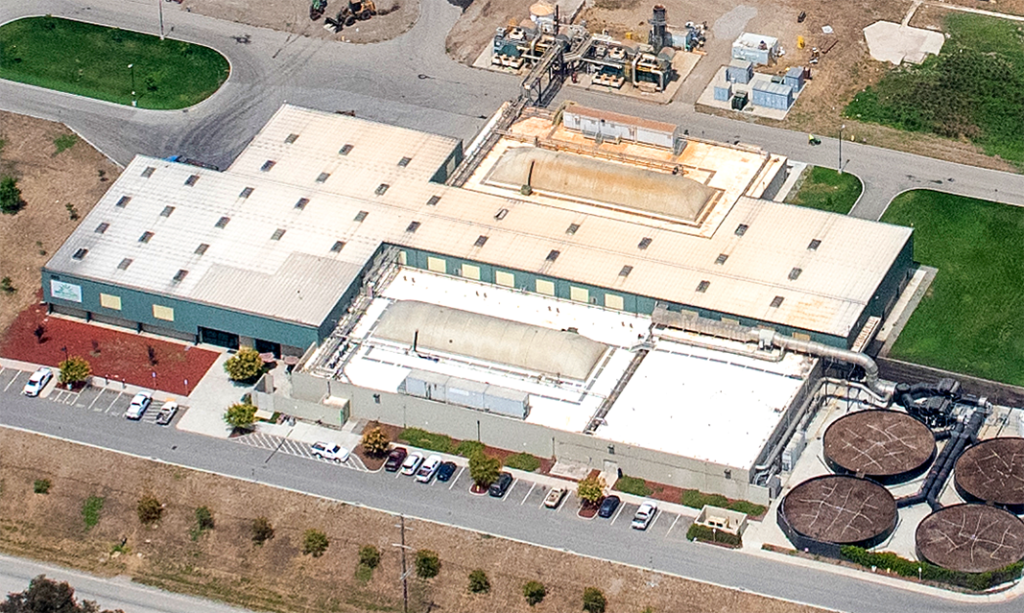
The ZWED high-solids dry fermentation anaerobic digester facility receives waste collected from commercial businesses in San Jose. Biogas is captured in the membrane covers visible on the top of the building.
ZWED installed Kompoferm dry fermentation digesters manufactured by Eggersmann Anlagenbau. When built out, the facility would have 270,000 tons/year of processing capacity. The first phase was designed for 90,000 tons/year; to date, the facility has not been expanded. The plant is comprised of 16 high-solids dry fermentation digesters and four in-vessel composting tunnels. Biogas is conditioned to remove hydrogen sulfide using an iron sponge (wood chips with iron on them), and then fed into two 800 kW 2G combined heat and power engines. Electricity is sold to Pacific Gas & Electric.
The first loads of processed MSW were delivered to the AD facility in December 2013. Over the years, the loads contained fewer and fewer organics, prompting reexamination of the contracts. “After a great deal of negotiation in late 2019 between the City of San Jose, Republic and Zanker, an agreement was reached that Republic would bring the commercial waste it collected directly to ZWED,” explains John Pena, the facility’s Operations Manager. “In May 2020, the loads started being delivered. Residues from our facility are delivered to Republic’s landfill on Newby Island in San Jose. The agreement guarantees tonnages on a quarterly basis, and the tip fee and the tonnages increase according to a schedule worked out between the parties. For example, the monthly tonnage limit in May 2021 (May 1-May 31) was 7,500 tons, the residue allotment was 3,107 tons, and the fee was $1.25 million.”
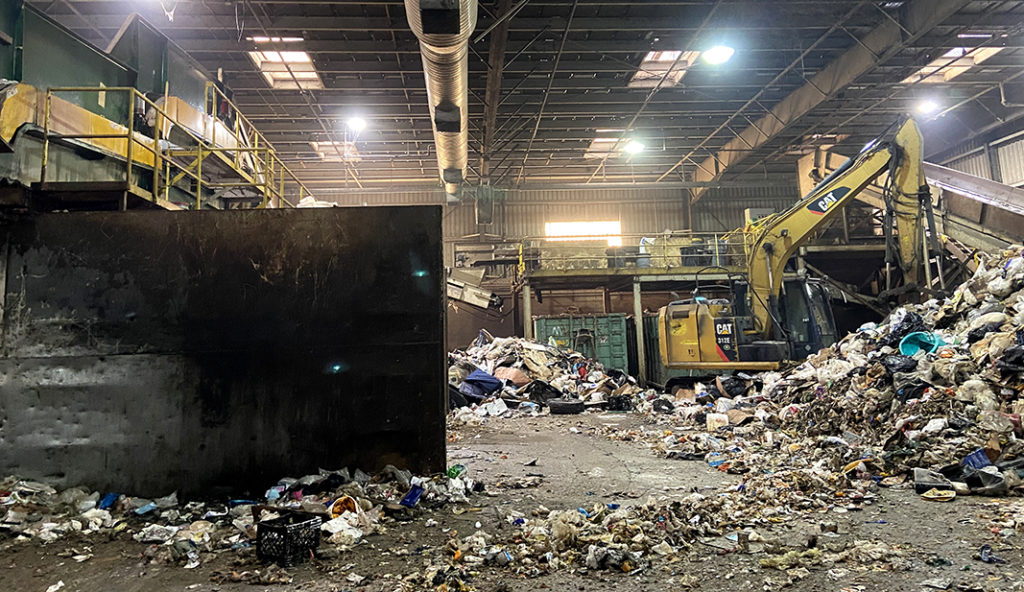
One of the preprocessing lines at the ZWED facility has a bag breaker (on right), a sorting line (center at top of photo) and a screen (on left) that sorts material into 2-inch and 4-inch minus fractions.
ZWED has two separate lines to process the incoming waste. The first includes a bag breaker, a sorting line to remove fiber, large bulky items and pieces of wood, and then a screen with 2-inch and 4-inch mesh. The second line has a shredder to size reduce all the material, followed by a screen that yields a 2-inch minus fraction. The fines from the first line and the 2-inch minus fraction from the second are loaded into the digesters, which operate at thermophilic temperatures (120°-130° F). Liquid (percolate), which is stored in a tank below the digesters, is circulated through the material, adding bacteria and moisture. It is captured in the tank and recycled back through the digesters.
Retention time in the digesters is 21 days after which oxygen is introduced prior to opening the doors. Material is unloaded and put into the in-vessel composting tunnels to remove remaining ammonia and dry the digestate. Retention time in the composting tunnels is 7 days. Material is unloaded and processed through a portable trommel with a 2.5-inch minus screen. “That evening, the screened material is hauled to Z-Best,” explains Pena. “The residue is around 35%. Right now, we are receiving about 450 tons/day of mixed waste and are permitted to take 650 tons/day, 7 days/week.”
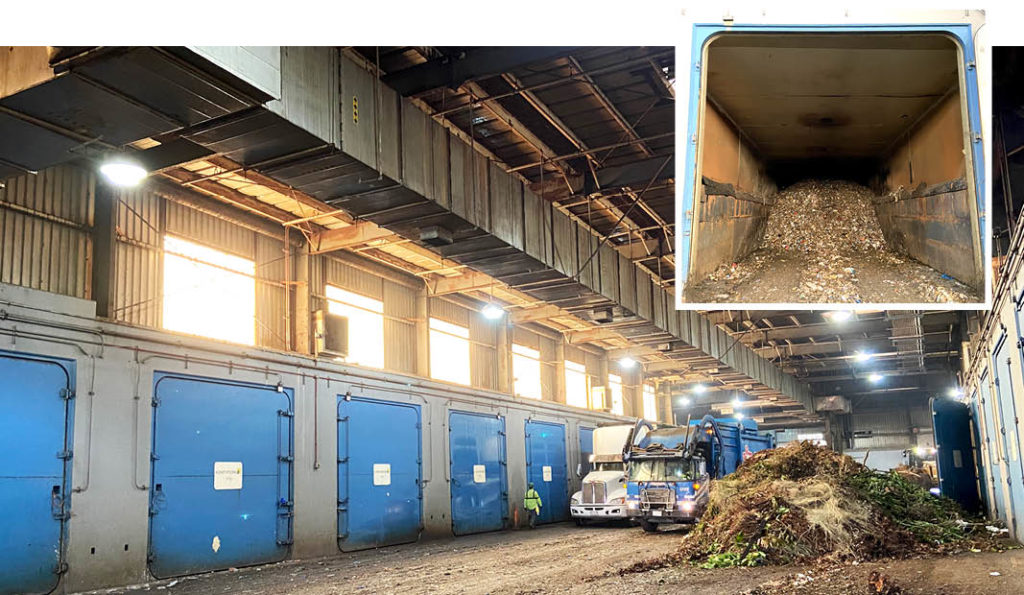
The plant is comprised of 16 high-solids dry fermentation digesters (blue doors and inset) and four in-vessel composting tunnels (not shown).
Biogas production has been increasing as the facility is receiving more organics in the loads. Restaurants are opening up again, with more food waste coming to the facility. In addition, ZWED is in regular discussions with the City and Republic about increasing separation and diversion of organics. The company has also added additional sorters to the line to remove more inert materials prior to anaerobic digestion.
“We are trying to find a sweet spot on how high to load the digesters to maximize gas production,” says Pena. “In March, April and May, we were able to run both engines the entire month, and that is continuing in June. That only happened one time before, which was in November 2016. Getting direct delivery of collected waste is definitely bringing us more organics. Before, we were getting the avocado pit, and now we are getting the avocado. It makes a huge difference in biogas production.”
With more Requests for Proposals for organics processing (and in some instances, collection) being issued by cities, counties and waste authorities in California, Zanker Recycling is looking forward to building out infrastructure in other areas in the northern part of the state. “Jurisdictions are seeing the writing on the wall,” says Gross. “Our approach to keeping organics in the trash container is an option, especially where they don’t have established source separation programs for organics.”



